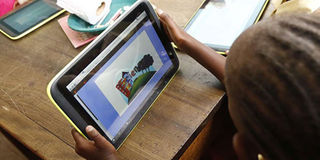Coronavirus shutdown reveals need for digital school syllabus

When the digital gadget-per-child programme is fully in schools, digital learning will become a reality. PHOTO | FILE | NATION MEDIA GROUP
What you need to know:
- With a simple screen and either main-grid electricity or solar power, schools that have for years suffered teacher shortages would benefit from pre-recorded or live-streamed lessons.
- Parents could start by letting their children access the digital learning materials from their phones, laptops and desktops as well as smart television sets.
The school shutdown announced by President Uhuru Kenyatta on March 15 after coronavirus was detected in the country has revived debate about digital learning.
The directive sent home 15 million primary and secondary school learners, barely weeks after they had resumed classes from the midterm break.
But there is a silver lining in the dark cloud that has hung over the world for the past three months.
Digital learning was actually a key campaign pledge of the Jubilee government back in 2013. This could be the appropriate time to breathe new life into a foresighted idea that could make a big difference.
The world has gone digital. Entire industries — including medicine, aviation and motoring, to name a few — have digitised their operations and the Kenyan education sector cannot afford to be left behind.
But it is important to take stock of what we have. The immediate need is to keep our children productively occupied until resumption of the normal school calendar.
STATE INITIATIVES
The government has already announced plans to step up its radio-based education broadcasts, which makes a lot of sense given its wide reach in rural Kenya.
Education Cabinet Secretary George Magoha also announced the transmission of lessons through the Kenya Institute of Curriculum Development-owned Edu-Channel TV.
The Edu-TV YouTube channel and Kenya Education Cloud are other initiatives the Ministry of Education is deploying to reach the learners.
Corporate bodies such as Longhorn Publishers have supported this initiative by providing approved textbooks for uploading free of charge, with Airtel Kenya and Jamii Telecommunications making them accessible on electronic gadgets at no data cost.
Nobody knows when the pandemic will come under manageable control. Infections and deaths are soaring in Europe and the United States, the two richest economies, which have a big sway on global affairs.
African countries are only now starting to reckon with the rapid spread of the virus, terrified by the sheer inadequacies of their health infrastructure but hoping to learn from others’ experiences.
WORKING INFRASTRUCTURES
All these uncertainties bring to the fore the concern over our learners’ ability to cover the syllabus this year and the best way to handle such outbreaks.
As always, simplicity is key in making acceptable and entrenching any solutions. Innovative local religious organisations have, for example, chosen to reach their members digitally.
The digital sermons, live as well as recorded, have carved a path that the education sector could follow and perfect.
Parents could start by letting their children access the digital learning materials from their phones, laptops and desktops as well as smart television sets.
With the deep penetration of solar-powered gadgets and telecommunication networks in the country, there is no reason why digital lessons should not be a way of life in our schools.
The Education ministry could roll out radio broadcasts to all public schools from as early as the 1970s; there’s no reason why that cannot be replicated, digitally and on a larger scale.
With a simple screen and either main-grid electricity or solar power, schools that have for years suffered teacher shortages would benefit from pre-recorded or live-streamed lessons.
BRIDGE GAP
Classes can be held simultaneously across the country, significantly helping learners to cover subjects for which they may not have teachers.
Of course, learning is two-way, and the importance of assignments and tests cannot be overstated.
But there are students who are set to sit the national examinations this year without having seen a teacher in the classroom for certain subjects. Digital learning could bridge this gap in a big way.
When the digital gadget-per-child programme is fully in schools, digital learning will become a reality and Kenya will have made a big leap into the new, technology-centred world.
Mr Mworia is group CEO, Centum Investment Company; @MworiaJ




